Instructional Labs
The new teaching laboratory (IB 135L) for the Mechanics of Organisms class is on Spring 2008.
Students Monitor Signals from the Neural Clock that Drives Running
CONTROL OF LOCOMOTION
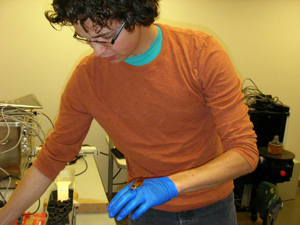 Recovery from perturbations during locomotion often requires the integration of mechanical and neural feedback (Dickinson et al., 2000). Tuned visco-elastic structures, such as legs, wings and fins, can provide mechanical feedback that is self-stabilizing (Full et al., 2002; Holmes et al., 2006). Sensors excited by large perturbations provide neural feedback that alters muscle activation patterns (Buschges, 2005). In most vertebrate muscles, the activation pattern from multiple motor units, termed an electromyogram (EMG), is difficult to quantify. Insects have key locomotor muscles that are innervated by a single excitatory motor neuron (Full et al., 1998). A neural clock in the nerve cord, termed a central pattern generator, sends a rhythmic signal to a muscle that produces
Recovery from perturbations during locomotion often requires the integration of mechanical and neural feedback (Dickinson et al., 2000). Tuned visco-elastic structures, such as legs, wings and fins, can provide mechanical feedback that is self-stabilizing (Full et al., 2002; Holmes et al., 2006). Sensors excited by large perturbations provide neural feedback that alters muscle activation patterns (Buschges, 2005). In most vertebrate muscles, the activation pattern from multiple motor units, termed an electromyogram (EMG), is difficult to quantify. Insects have key locomotor muscles that are innervated by a single excitatory motor neuron (Full et al., 1998). A neural clock in the nerve cord, termed a central pattern generator, sends a rhythmic signal to a muscle that produces
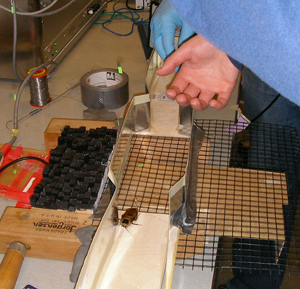
bursts of muscle action potentials (MAPs). These bursts activate the muscle to generate force
and/or produce work. Muscle action potentials bursts can be characterized by: 1) the number of MAPs or spikes per burst, 2) the time between MAPs within a burst (interspike interval, or ISI), and 3) the time between bursts (interburst interval, or IBI). Neural feedback providing astabilization response to a perturbation will alter the MAP bursts.
OBJECTIVE
In this laboratory students measure the voltage of muscle action potentials directly from a leg muscle in a running insect by inserting an electrode. They compare the pattern of activation for cockroaches running over flat versus rough terrain. They determine the change in the pattern of activation resulting from neural feedback in response to the perturbations produced by the rough terrain.
Students Determine the Materials Properties of Bird Flight and Squid Jetting Muscle
PROPERTIES OF BIOMATERIALS
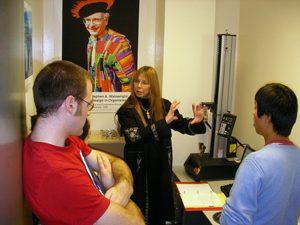 Mechanical tests of biomaterials can be used to measure basic mechanical properties of the tissues (including the ones you will measure in this exercise: stiffness, strength, extensibility, toughness, resilience, plastic deformation, time-dependent visco-elastic behavior, stress-softening behavior). Such information can be useful for designing human-made replacements for such tissues (for example, in prosthetics). Mechanical tests can indicate the sorts of molecular mechanisms likely to be responsible for the physical properties of a tissue. Coupling mechanical testing with analysis of the micro-architecture of composite biomaterials and their chemical composition can provide insights about how the performance of a biomaterial depends on its structure, and such principles can provide inspiration for the design of biomimetic materials. Mechanical tests can also allow us to calculate the passive physical responses of organisms
Mechanical tests of biomaterials can be used to measure basic mechanical properties of the tissues (including the ones you will measure in this exercise: stiffness, strength, extensibility, toughness, resilience, plastic deformation, time-dependent visco-elastic behavior, stress-softening behavior). Such information can be useful for designing human-made replacements for such tissues (for example, in prosthetics). Mechanical tests can indicate the sorts of molecular mechanisms likely to be responsible for the physical properties of a tissue. Coupling mechanical testing with analysis of the micro-architecture of composite biomaterials and their chemical composition can provide insights about how the performance of a biomaterial depends on its structure, and such principles can provide inspiration for the design of biomimetic materials. Mechanical tests can also allow us to calculate the passive physical responses of organisms 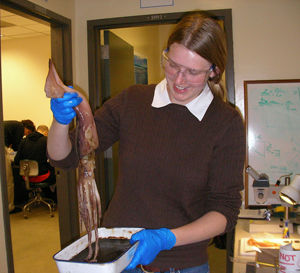 or parts of organisms to mechanical loading situations they would experience while performing various activities or being subjected to environmental forces.
or parts of organisms to mechanical loading situations they would experience while performing various activities or being subjected to environmental forces.
OBJECTIVES
Students gain hands-on experience in conducting the basic materials testing procedures using an Instron Materials Testing Machine. Students discover many of the issues that must be considered and the practical problems that must be solved to test biological tissues in ways that are biologically-relevant and will answer important biological questions.
Students Capture One of Nature’s Fastest Runners with High-Speed Video Cameras
KINEMATICS OF BEHAVIOR
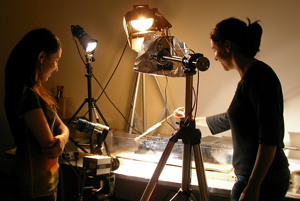 Kinematic analysis provides a quantitative description of motion (Biewener and Full, 1992). Rhythmic behaviors such as swimming, flying and running can be characterized by common variables. For example, in legged terrestrial locomotion: Stride = one complete cycle of leg movements. Stride period = time to complete one stride. Stride frequency = # of strides/time (cycles/s or Hz). Stride length = distance traveled / stride. Speed = stride length * stride frequency. Duty factor = stance or contact time /stride period. Phase = place in the cycle (0 to 1.0) where an event occurs. Gait = the pattern of leg movements during one stride. Kinematic variables are frequently used to determine gaits. Traditionally, a running gait has been defined by the presence of an aerial phase. Alternatively, gaits may be best characterized by considering both the kinematics (motion) and the kinetics (forces). Walking and running can be modeled by a spring loaded inverted pendulum (SLIP; Alexander,
Kinematic analysis provides a quantitative description of motion (Biewener and Full, 1992). Rhythmic behaviors such as swimming, flying and running can be characterized by common variables. For example, in legged terrestrial locomotion: Stride = one complete cycle of leg movements. Stride period = time to complete one stride. Stride frequency = # of strides/time (cycles/s or Hz). Stride length = distance traveled / stride. Speed = stride length * stride frequency. Duty factor = stance or contact time /stride period. Phase = place in the cycle (0 to 1.0) where an event occurs. Gait = the pattern of leg movements during one stride. Kinematic variables are frequently used to determine gaits. Traditionally, a running gait has been defined by the presence of an aerial phase. Alternatively, gaits may be best characterized by considering both the kinematics (motion) and the kinetics (forces). Walking and running can be modeled by a spring loaded inverted pendulum (SLIP; Alexander, 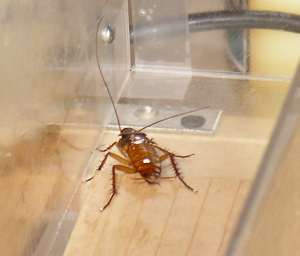 1984). Gait transitions can be predicted by dynamic similarity theory using Froude numbers (Alexander and Jayes, 1983).
1984). Gait transitions can be predicted by dynamic similarity theory using Froude numbers (Alexander and Jayes, 1983).
OBJECTIVE
In this laboratory students quantify the leg movements of an insect as a function of speed using high-speed cameras. Students measure general kinematic variables as a function of speed. Stuents determine at what speed cockroaches change gait from a walk to a run by searching for an aerial phase.
Students Measure the Energetic Cost of Running Insects that Heat their Body to Human Temperatures
EFFICIENCY OF ACTIVITY
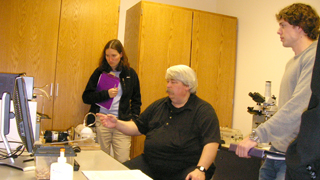 The term efficiency in biomechanics has been defined in many different ways and is used in many different contexts (Blickhan and Full, 1992). Energy input determined by an animal’s metabolic cost is often an essential part of the equation. The best indicator of metabolic cost is oxygen consumption, as long as the maximal rate of oxygen delivery is not exceeded. The metabolic energy input used by animals can be estimated from the rate at which they consume oxygen (1 ml O2 consumed = 20.1 J). In mammals, birds, lizards and salamanders, the metabolic cost of steady-state, terrestrial locomotion increases linearly with speed (Full, 1991). Not only can the metabolic cost per unit time be important to an animal, so can the cost required to travel a given distance. The metabolic cost per unit distance can be obtained by dividing the rate of oxygen consumption by speed. This is a useful measure of locomotor energetics similar to automobile economy, miles / gallon, but simply inverse, J / m. Energy cost per distance in most animals is a function of speed. The minimum cost of locomotion is attained at the fastest speeds animals can sustain and can be calculated as the slope of the oxygen consumption versus speed function. The minimum
The term efficiency in biomechanics has been defined in many different ways and is used in many different contexts (Blickhan and Full, 1992). Energy input determined by an animal’s metabolic cost is often an essential part of the equation. The best indicator of metabolic cost is oxygen consumption, as long as the maximal rate of oxygen delivery is not exceeded. The metabolic energy input used by animals can be estimated from the rate at which they consume oxygen (1 ml O2 consumed = 20.1 J). In mammals, birds, lizards and salamanders, the metabolic cost of steady-state, terrestrial locomotion increases linearly with speed (Full, 1991). Not only can the metabolic cost per unit time be important to an animal, so can the cost required to travel a given distance. The metabolic cost per unit distance can be obtained by dividing the rate of oxygen consumption by speed. This is a useful measure of locomotor energetics similar to automobile economy, miles / gallon, but simply inverse, J / m. Energy cost per distance in most animals is a function of speed. The minimum cost of locomotion is attained at the fastest speeds animals can sustain and can be calculated as the slope of the oxygen consumption versus speed function. The minimum 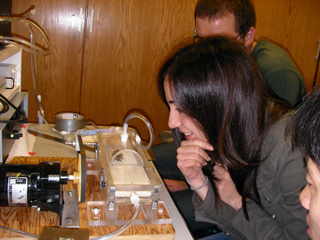 cost of locomotion is a very useful index because animals that run at different speeds and use different amount of oxygen at rest can still be compared. The minimum cost of locomotion is often expressed mass-specifically, J / (kg m), to show the cost relative to body mass. If the mass-specific, minimum cost of terrestrial locomotion is divided weight instead of mass, it is termed specific resistance. Specific resistance is a value not only used to compare swimming, flying and running animals, but it is the preferred method for comparison of vehicles in engineering.
cost of locomotion is a very useful index because animals that run at different speeds and use different amount of oxygen at rest can still be compared. The minimum cost of locomotion is often expressed mass-specifically, J / (kg m), to show the cost relative to body mass. If the mass-specific, minimum cost of terrestrial locomotion is divided weight instead of mass, it is termed specific resistance. Specific resistance is a value not only used to compare swimming, flying and running animals, but it is the preferred method for comparison of vehicles in engineering.
OBJECTIVE
Students measure the oxygen consumption of cockroaches running on a treadmill. By running the animal over a range of speeds, you will calculate its minimum cost of transport and its specific resistance. Students compare this value to the value predicted for animals of a similar mass. Students use this value to estimate its efficiency.


